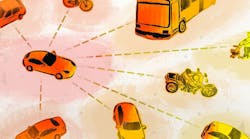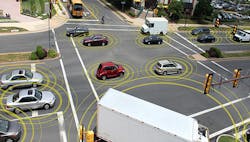Proposed Safety Rules Would Require Cars to Talk to Each Other
A rule proposed by the Department of Transportation on Tuesday signaled that officials intend for cars not only to see but also to talk with each other wirelessly. If passed, the rule would require all cars and small trucks to be equipped with radio technology to improve safety and reduce road congestion.
Vehicle-to-vehicle, or V2V, communications enable cars to share their location, speed and the direction they are traveling ten times per second. Officials say that the data could help cars detect when another vehicle breaks suddenly or speeds around a blind corner. Then, a warning can be send to the dashboard or an automated safety system can prevent a crash.
The communications systems would supplement cameras, radar, and other sensors to protect against fatal accidents, officials said. The National Highway Transportation and Safety Administration said that V2V technology could reduce 80 percent of crashes that don’t involve alcohol or drugs.
“We are carrying the ball as far as we can to realize the potential of transportation technology to save lives,” said U.S. Transportation Secretary Anthony Foxx in a statement. “Once deployed, V2V will provide 360-degree situational awareness on the road and will help us enhance vehicle safety.”
The proposed rule will require vehicles to “speak the same language” through standardized messages that cars broadcast to each other. The messages are anonymous and will not contain any information on the owner of the vehicle, make or model, or license plate. They are also not saved, making it impossible to use the data to track where a particular vehicle has been. Officials also said that the communications would be encrypted.
The proposal, which will be open for three months of public comment, calls for half of all new vehicles to have the technology two years after a final rule is issued. All vehicles will be required to have the technology after four years. Officials said they expect a final rule to be released in 2019.
The Federal Highway Administration said that it would offer separate advice to help transportation planners equip V2V devices to roadway infrastructure such as traffic lights, stop signs, and construction zones. Cars could leave details about road conditions with infrastructure devices embedded in a highway sign and pass that data onto other cars. V2V hardware might also be included in smartphones to give cars a map of nearby pedestrians.
Automakers will not wait for the rule to be issued before laying out production plans for the technology, in the opinion of industry executives. “The industry is not going to look at the actual date when this become a mandate,” said Ravi Puvvala, the chief executive of Savari, a start-up that makes V2V hardware and the software that controls it. “They are not going to wait for someone to turn the technology on.”
Many have not waited. General Motors and Mercedes have both said they will include V2V technology in 2017 models. Earlier this year, Toyota said that it would equip 5,000 cars in the city of Ann Arbor, Michigan, with wireless communications systems to better understand how sharing data could improve safety.
The problem is that it could take decades for all the vehicles on the road to start communicating. The process of spreading V2V system throughout the fleet could be shortened by devices that enable drivers to add the technology to older vehicles. Puvvala thinks that, with the proposal, aftermarket companies will start making devices integrated with V2V.
“The benefits only increase as more and more vehicles have this capability, for which this mandate provides a strong foundation,” said Kurt Sievers, general manager of the automotive business at NXP Semiconductors, in a statement. He added that V2V technology could work with autonomous driving systems to better avoid crashes and improve traffic flow. The cars could synchronize their movements, safely traveling in closely-packed platoons on highways.
V2V sends and receives messages around 1000 feet away, letting cars sense other vehicles even when the driver’s sight is blocked by buildings or other obstacles. That gives the technology the advantage of being able to detect a potential collision before the driver or vehicle cameras can anticipate the collision.
There are hurdles to widespread V2V communications. Technology companies have pressured the Federal Communications Commission to open up the 5.9 GHz radio spectrum that Congress specifically set aside for V2V applications in 1999. The companies want permission to access the spectrum for faster Wi-Fi. The FCC is now investigating whether Wi-Fi would interfere with V2V.
It is not clear how President-elect Donald Trump and his choice for transportation secretary, Elaine Chao, would approach the V2V communications rules. Also unclear is the fate of the V2V spectrum now that Tom Wheeler, the FCC’s chairman, said he would step down from agency on January 20.



